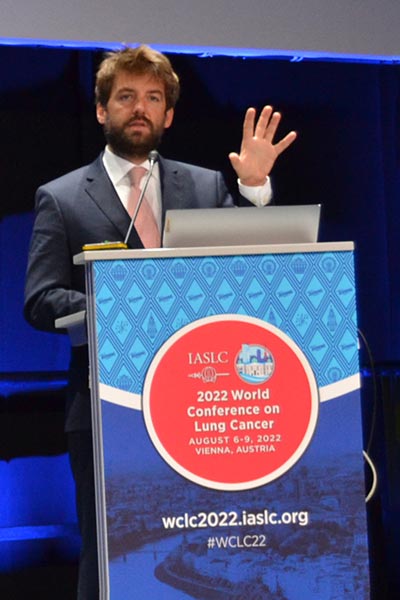
In the rapidly evolving field of artificial intelligence (AI) and machine learning (ML), new algorithms and deep-learning models have been developed to help physicians identify lung cancer on CT scans. During the fourth plenary session of this year’s scientific program, Artificial Intelligence in Lung Cancer, a multidisciplinary panel of experts discussed the current and future applications of AI in the detection, diagnosis, and treatment of lung cancer.
Douglas J. Hartman, MD, associate professor of pathology and vice chair of the Division of Pathology Informatics at the University of Pittsburgh Medical Center, opened the session with a discussion of the current status of digital pathology and possible implications for treatment of lung cancer.
“We’re seeing increasing interest in using digital pathology, particularly in Europe, as, more and more, the development of artificial intelligence and machine learning is providing us with some very useful tools,” Dr. Hartman said.
Beyond tumor detection, he said that artificial intelligence and machine learning have the potential to assist in the interpretation of biomarkers and in major pathological response assessment, as well as “rare event” detection.
“There are all kinds of different ways to slice up how these tools could be potentially used. At my institution, for example, we’ve deployed an open-loop machine learning model to help pathologists with the task of finding rare organisms,” Dr. Hartman said. “Artificial intelligence and machine learning is the next iteration of tools we will use to develop complex reports; and these constitute a new powerful tool that will be used by pathologists in the diagnosis and prediction of lung cancer.”
Looking at the applications for artificial intelligence and machine learning in radiology, Fergus Gleeson, MD, professor and head of Academic Radiology at Oxford University, said the potential is promising but that there are challenges to overcome to fully realize that potential.
“It’s important to remember that we’re still at the start of using these technologies, and we are still a long way from having AI work the way we think and hope it will work,” Dr. Gleeson said.
The major challenge, he said, is that the AI can only detect what it is “trained” to detect, and that human involvement is necessary to know when to trust the technology and when to override it.
“Although you think it can identify a pulmonary nodule on a CT scan as a cancer, not all nodules are built equally and not all CT scans are built equally,” he said. “One of the things we humans can do is manage uncertainty—algorithms can’t manage uncertainty.”
In the field of radiation oncology, on the other hand, the promise of AI and machine learning is becoming increasingly clear, according to Jean-Emmanuel Bibault, MD, PhD, Professor of Radiation Oncology at the Université de Paris/Hôpital Européen Georges Pompidou in France.
Currently, he said, AI in radiation oncology is mostly focused on what humans can do in the context of treatment planning—segmentation and dosimetry, for example.
“It won’t be long, though, before it will also be able to do what humans can’t do in terms of predictive and prognostic modeling, leading to better personalized medicine,” Dr. Bibault said. “Tools are currently being developed and validated and I believe within five to ten years, we will be able to take the complete pipeline of treatment planning and automate it completely, even for lung cancer.”
In the final presentation of the session, Georg Langs, PhD, professor of Machine Learning in Medical Imaging at the Medical University of Vienna, talked about how “big data” will drive the future of artificial intelligence in better detecting, treating, and understanding lung cancer.
“When we are talking about big data in this context, we are talking about patients and the attempt to learn something from large populations,” he said. “What we want to be able to do when we look at the data and when we look at large-scale populations is detect patients who we can treat well with the treatments that we currently have. I think lung cancer screening is a prime example for that.”
As Dr. Gleeson suggested during the Q&A discussion, AI and ML will not replace human agency, but ideally enhance and expedite medical decision making.










